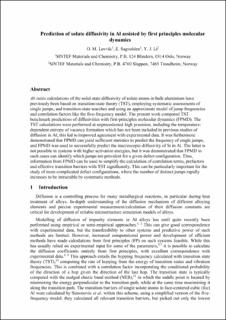| dc.contributor.author | Løvvik, Ole Martin | |
| dc.contributor.author | Sagvolden, Espen | |
| dc.contributor.author | Li, Yanjun | |
| dc.date.accessioned | 2020-12-30T11:37:04Z | |
| dc.date.available | 2020-12-30T11:37:04Z | |
| dc.date.created | 2013-12-16T15:54:33Z | |
| dc.date.issued | 2014 | |
| dc.identifier.citation | Journal of Physics: Condensed Matter. 2014, 26 (2), . | en_US |
| dc.identifier.issn | 0953-8984 | |
| dc.identifier.uri | https://hdl.handle.net/11250/2721120 | |
| dc.description.abstract | Ab initio calculations of the solid-state diffusivity of solute atoms in bulk aluminium have previously been based on transition state theory (TST), employing transition state searches and systematic assessments of single jumps together with appropriate models of jump frequencies and correlation factors like the five-frequency model. This work compared TST benchmark predictions of diffusivities with first-principles molecular dynamics (FPMD). The TST calculations were performed at unprecedented high precision, including the temperature dependent entropy of vacancy formation which has not been included in previous studies of diffusion in Al; this led to improved agreement with experimental data. It was furthermore demonstrated that FPMD can yield sufficient statistics to predict the frequency of single jumps, and FPMD was used to successfully predict the macroscopic diffusivity of Si in Al. The latter is not possible in systems with higher activation energies, but it was demonstrated that FPMD in such cases can identify which jumps are prevalent for a given defect configuration. Thus, information from FPMD can be used to simplify the calculation of correlation terms, prefactors and effective transition barriers with TST significantly. This can be particularly important for the study of more complicated defect configurations, where the number of distinct jumps rapidly increases to be intractable by systematic methods. | en_US |
| dc.language.iso | eng | en_US |
| dc.publisher | IOP Publishing | en_US |
| dc.title | Prediction of solute diffusivity in Al assisted by first-principles molecular dynamics | en_US |
| dc.type | Peer reviewed | en_US |
| dc.type | Journal article | en_US |
| dc.description.version | acceptedVersion | en_US |
| dc.rights.holder | This is the Accepted Manuscript version of an article accepted for publication in Journal of Physics: Condensed Matter. IOP Publishing Ltd is not responsible for any errors or omissions in this version of the manuscript or any version derived from it. The Version of Record is available online at https://iopscience.iop.org/article/10.1088/0953-8984/26/2/025403 | en_US |
| dc.source.pagenumber | 10 | en_US |
| dc.source.volume | 26 | en_US |
| dc.source.journal | Journal of Physics: Condensed Matter | en_US |
| dc.source.issue | 2 | en_US |
| dc.identifier.doi | 10.1088/0953-8984/26/2/025403 | |
| dc.identifier.cristin | 1077456 | |
| dc.relation.project | Norges forskningsråd: NN2615K | en_US |
| dc.relation.project | Norges forskningsråd: 193179 | en_US |
| dc.source.articlenumber | 025403 | en_US |
| cristin.unitcode | 7401,80,6,0 | |
| cristin.unitname | Materialer og nanoteknologi | |
| cristin.ispublished | true | |
| cristin.fulltext | postprint | |
| cristin.qualitycode | 1 | |
